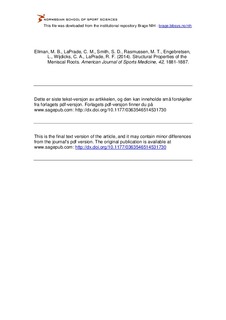| dc.contributor.author | Ellman, Michael B. | |
| dc.contributor.author | LaPrade, Christopher M. | |
| dc.contributor.author | Smith, Sean D. | |
| dc.contributor.author | Rasmussen, Matthew T. | |
| dc.contributor.author | Engebretsen, Lars | |
| dc.contributor.author | Wijdicks, Coen A. | |
| dc.contributor.author | LaPrade, Robert F. | |
| dc.date.accessioned | 2015-06-03T09:15:31Z | |
| dc.date.available | 2015-06-03T09:15:31Z | |
| dc.date.issued | 2014-05-05 | |
| dc.identifier.citation | American Journal of Sports Medicine. 2014, 42, 1881-1887 | nb_NO |
| dc.identifier.uri | http://hdl.handle.net/11250/284489 | |
| dc.description | I Brage finner du siste tekst-versjon av artikkelen, og den kan inneholde ubetydelige forskjeller fra forlagets pdf-versjon. Forlagets pdf-versjon finner du på www.sage.com: http://dx.doi.org/10.1177/0363546514531730 / In Brage you'll find the final text version of the article, and it may contain insignificant differences from the journal's pdf version. The original publication is available at www.sage.com: http://dx.doi.org/10.1177/0363546514531730 | nb_NO |
| dc.description.abstract | Background: Current surgical techniques for meniscal root repair reattach the most prominent, dense portion of the meniscal root and fail to incorporate recently identified peripheral, supplemental attachment fibers. The contribution of supplemental fibers to the biomechanical properties of native meniscal roots is unknown.
Hypothesis/Purpose: The purpose was to quantify the ultimate failure strengths, stiffness, and attachment areas of the native posterior medial (PM), posterior lateral (PL), anterior medial (AM), and anterior lateral (AL) meniscal roots compared with the most prominent, dense meniscal root attachment after sectioning of supplemental fibers. It was hypothesized that the ultimate failure strength, stiffness, and attachment area of each native root would be significantly higher than those of the respective sectioned root.
Study Design: Controlled laboratory study.
Methods: Twelve matched pairs of male human cadaveric knees were used. The 4 native meniscal roots were left intact in the native group, whereas the roots in the contralateral knee (sectioned group) were dissected free of all supplemental fibers. A coordinate measuring device quantified the amount of tissue resected in the sectioned group compared with the native group. A dynamic tensile testing machine pulled each root in line with its circumferential fibers. All root attachments were preconditioned from 10 to 50 N at a rate of 0.1 Hz for 10 cycles and subsequently pulled to failure at a rate of 0.5 mm/s.
Results: Supplemental fibers composed a significant percentage of the native PM, PL, and AM meniscal root attachment areas. Mean ultimate failure strengths (in newtons) of the native PM, PL, and AM roots were significantly higher than those of the sectioned state, while the ultimate failure strength of the native AL root was indistinguishable from that of the sectioned state.
Conclusion: Three of the 4 meniscal root attachments (PM, PL, AM) contained supplemental fibers that accounted for a significant percentage of the native root attachment areas, and these fibers significantly contributed to the failure strengths of the native roots. | nb_NO |
| dc.language.iso | eng | nb_NO |
| dc.publisher | Sage | nb_NO |
| dc.subject | meniscus root | nb_NO |
| dc.subject | root repair | nb_NO |
| dc.subject | meniscal repair | nb_NO |
| dc.subject | posterior meniscus root, medial meniscus | nb_NO |
| dc.subject | lateral meniscus | nb_NO |
| dc.title | Structural properties of the meniscal roots | nb_NO |
| dc.type | Journal article | nb_NO |
| dc.type | Peer reviewed | nb_NO |
| dc.subject.nsi | VDP::Social science: 200::Social science in sports: 330 | nb_NO |
| dc.subject.nsi | VDP::Medical disciplines: 700::Clinical medical disciplines: 750 | nb_NO |
| dc.subject.nsi | VDP::Medical disciplines: 700::Sports medicine: 850 | nb_NO |
| dc.source.journal | American Journal of Sports Medicine | nb_NO |
| dc.description.localcode | Seksjon for idretssmedisinske fag / Department of Sports Medicine | nb_NO |
